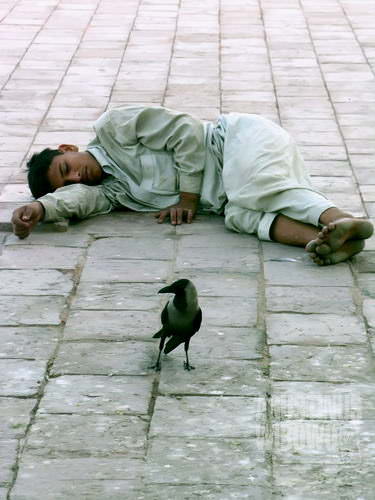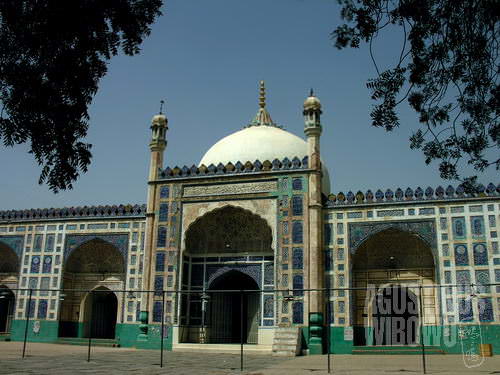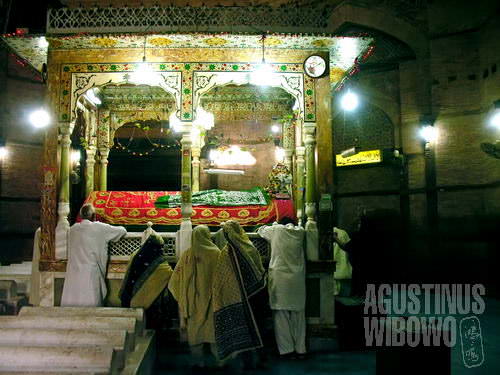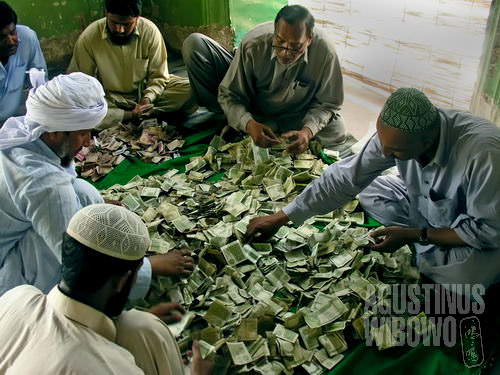Multan – The Mausoleums of Multan
May 2, 2006

Bahauddin Zakariya Mausoleum in Multan
The old city of Multan was among the first places in Pakistan to be converted to Islam by Mohammad bin Qasim. At that time Multan was a center of a Brahmin kingdom, led by a Brahmin king of Darra. Nothing left in Multan of its pre-Islamic history. The city had became a major pilgrimage for the Muslims all around the country as many of the mausoleums of the holy men of the religion are located here.
The most famous mausoleum of Multan might be the Mazhar of Sheikh Rukn-i-Alam. The building of the mausoleum was fantastic, reminded me to the Moghul mosques and mausoleums of Uzbekistan (they were all Moghuls anyway). Rukn-i-Alam means pillars of the world. A large number of pilgrims come here everyday, to pray around the tomb inside the mausoleum building. Rukn-i-Alam is a leader of the Suhrawardiya Sufi sect, so both of Sunni and Shiah pilgrims come here. To come to the mausoleum, one should leave the shoes and sandals outside. There was a caretaker who would get money of 2 Rs everytime he returned the shoes. I saw a shoe caretaker of another gate, refused two old women to come in. The women were pilgrims from village area nearby, and wearing no shoes. So the caretaker couldnt earn the 2 Rs of shoe storing fee, and he refused them an entry.
Inside the mausoleum there were also men asking for donations. He put some 10 Rs or 20 Rs of banknotes on his donation cap. People usually didnt give him donation, as this will go to the man’s own pocket. When some people paid him 1 or 5 Rs coin, he immediately took the coin to his pocket, to give image to next donators that the donation was only 10 and 20 Rs.
There were special place for women, in the mausoleum, behind the purdah. But actually women also pray together with the men in the same room. They touched the tomb, kissed the green textile covering it, reading prayers, some even cried emotionally. The men also did the same, from the other side. Some sat next to the walls and read the prayers seriously.

A beautiful dream
Not far from the mausoleum was the other mausoleum housing the body of Rukn-i-Alam’s father, Baha-ud-din-Zakaria. This mausoleum is 50 years older than the first one, decorated more simply, but still amazing Mughal piece of architecture. One of the caretakers, Muhammad from Sindh, took me around, asked me to read kalimah, asked me to take pictures of some women (I refused), then joked with some little boys nearby. He claimed a boy to be his son, the boy was not happy and cursed him as Sindhi bandar (a monkey from Sindhi). Muhammad is also a donation collector, maintaining the incense and candles and get paid from the pilgrims for that. Another man was selling flowers to be sprayed on the tomb by the pilgrims.
I went up north to the gigantic Eid Gah Masjid. Also another example of Mughal architecture. The blue colour gave the feeling of coolness, despite the boiling heat of Multan’s noon. There were children from the madrassah studying to chant the Quran inside the masjid. Outside, there were two young men were studying, under the shade of trees. They were not of the madrasah, nor studying Islamic studies. In fact, one boy was studying statistic, for his FSc exam next week, the other was studying English for his BA exam. I was surprised by the boy who was studying English. I asked him why he read only one text book with several texts in it, and it seemed that he was trying to memorize the texts in the book. He said that the test was indeed memorizing. The teacher would give a title of a text (random for each student) and the student had to re-write the text with exact wording from the textbook. I counted the words of the first text, it was not less than 385 words. And there were 8 texts to memorize.

Masjid Eid Gah
Pakistanis are always proud of the fact that they developed the nuclear weapons, as for them, it’s the sign of a powerful country. The students asked me why Indonesia didnt have atom? Indonesia was not atomic country at all, which for them was an example of a weak country. Hmmm… it was because we didnt have an extreme enemy at our neighbourhood at this moment, I guess.
The next mausoleum I visited was that one of Shams-ud-Din Sabzwari from Tabrez, Iran. Actually when trying to find this mausoleum I went to another small one of a lesser-known baba ji. Multan had uncountable of mazars. The caretaker of this mazar gave me a book named “the bones of kings”. The book is a speech of a renowned religious leader in Karachi, and talked about life after death and how to avoid the penalties in the grave.
The mausoleum of Shah Shams automatically made me remember to the Shiah sect. There were blag flags, the maatam chanting from the surrounding stalls, the hand palm sign of the Shiah, and even the writing of “Ya Ali Madad” (O… Ali Help) everywhere. There were some beggars outside, mostly old women. And there was also qawalli players to the entrance.

Qawwali music in Shah Shams mausoleum

Pilgrimage to holy tomb—pilgrims touch and kiss everything inside the building
When I asked whether Shah Shams was Shiah to the caretaker, he denied. “No, he was Ahl-i-Sunnat”. Ahl-i-Sunnat was the other name of the Sunnis. But the bulb with Ya Ali Madad writing near the tomb was a significant sign. He said that someone donated the bulb so he couldnt refuse. Donation and could not refuse? I just thought that he was denying at all that the mazhar was of a Shiah leader. This caretaker knows two Indonesian words: “Selamat pagi” and “istri”. He said that his friend from Saudi Arabia had some Indonesian friends so he noted these two words. Now he had chance to practise, finally.
Later the caretakers had a weekly work. A hard work. That was counting the donation in the donation box. It was a mountain of money: banknotes and coins. He said that at least for weekly donation they got 20,000 Rs, and on the top of the lucky days, they could get even 2 lakh rupees. There were five men separating the money, the 500 Rupee bills (I saw only one), 100 Rs bills (quite a lot), 50 Rs (more), 20 Rs (a small hill), 100 Rs (resembled a mountains), and a bunch of coins (omg, luckily I didnt need to deal with this). There was even a cute donator who put a cute photocopy money bill of 10 Rs with stamped “Piyare bacche, sab se acche“. The rhyme means “lovely childs, are the best”.

Counting alms
Where the money goes? To the government. All? Yes. The government then would decide the using of this donation money. There was a banker there, from a government bank, counting the money and made notes. There was also the responsible man of this mazar, the most important man at this time, the direct descendant of Shah Shams, Mr Syed Zahid Hussain. He was a beautiful old man, with quite European look, dressed in pure white shalwar khameez. Syed means he was a direct descendant of the Prophet Muhammad, Peace be Upon Him.
He said that he had been to Saudi Arabia and Iran, for Ziarat. Then I asked whether the Shias come to this mazar. But I used the term “Aliwallah”, the followers of Ali, which pleased him. Yes, this is a mazar for Aliwallah. Actually he meant that all people were Aliwallah, including the Ahl-i-Sunnat (The Sunnis). But Agha Khani (the Ismailis from northern Pakistan)? “No, they are not”

Mausoleum of Rukni Alam
The pilgrims of this mazar are not so many as the previous two ones. Some pilgrims yelled “Ya…. ALI!!!” inside the tomb room. I had lunch with the caretakers. They were inviting me, and specially ordered biryani as I told them I ate rice. They were discussing about a guy who made joke of the Shiah holy sentence (kalimah) in the bazaar, and one guy was very angry about it.
Later I visited one of the shops outside the mazar. There were collections of flags, mostly black (the colour of Shiah), some green, some other colors. There was collection of the photos of the father of Mr Syed Zahid, the previous pir-shahab of the mazar. There was a picture with many images of important walis in Pakistan Islam (or Shiah?) history. There were also some knives used in zanjir zani self-beating ceremony during the Muharram mourning mounds. The shopkeeper never did zanjirzani, but his brother did. I gave him motivation, “koshis karo na!” (“just try it!”). “Inshallah, next year,” he replied.



Leave a comment